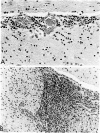Abstract
Groups of 4 guinea-pigs were immunized with acid extracts prepared from bovine myelin (EF), normal human liver tissue and malignant or benign neoplastic tissues in Freund's complete adjuvant (FCA1. The animals were weighed daily and examined for clinical signs of experimental allergic encephalomyelitis (EAE). All the animals immunized with EF developed clinical symptoms of EAE within 21 days of the initial immunization, whilst some of the animals immunized with certain tumour extracts developed symptoms which closely resembled those of EAE. Control animals immunized with FCA only remained asymptomatic. Cellular immunity to the various extracts in immunized animals was assessed 20 days after immunization by i.d. skin testing, and upon killing at Day 21 with the direct peritoneal-exudate macrophage migration inhibition (MMI) test. Brains and spinal cords were removed at killing, fixed in formalin and processed for histological examination. I.d. skin testing was shown to be most consistent in demonstrating positive delayed hypersensitivity, whilst the MMI test frequently gave negative results in the presence of pronounced skin responses to specific extracts. Thus it was shown that 3/4 animals immunized with basic proteins extracted from an adenocarcinoma of the lung or related hepatic metastases, and 1/2 animals immunized with an extract of a carcinoma of the breast, gave intense erythema and induration responses 5 mm in diameter 24 h after i.d. challenge with EF. No such response was obtained in animals immunized with basic proteins extracted from normal human liver, any of the other neoplastic tissues, or in control animals immunized with FCA only. Examination of brains and spinal cords from animals immunized with EF revealed dense infiltration by mononuclear cells in the ependyma and choroid plexus of levels in the spinal cord. Examination of brains and spinal cords from animals immunized with the lung-tumour extract or related hepatic metastases which showed demonstrable immunological cross-reactivity with EF in immunized animals, revealed a number of inflammatory changes characterized by dense infiltrates of mononuclear cells sub-ependymally, and perivascular cuffing in the cortex. However, no significant lesions were seen in the spinal cords of these animals. Polyacrylamide-gel electrophoresis of the 2 tumour extracts exerting this apparent encephalitogenic effect did not reveal proteins within the mol. wt range of EF. Thus the observed pathological effects and cross-reactivity with EF were probably not due to contamination with nervous-tissue components. It is suggested that these tumour extracts may have contained a component or components other than EF, immunologically cross-reactive with EF, and capable of inducing the observed encephalitis.
Full text
PDF












Images in this article
Selected References
These references are in PubMed. This may not be the complete list of references from this article.
- Arvilommi H., Dale M. M., Desai H. N., Mongar J. L., Richardson M. Failure to obtain positive MEM tests in either cell-mediated immune conditions in the guinea-pig or in human cancer. Br J Cancer. 1977 Nov;36(5):545–549. doi: 10.1038/bjc.1977.229. [DOI] [PMC free article] [PubMed] [Google Scholar]
- Caspary E. A., Field E. J. Specific lymphocyte sensitization in cancer: is there a common antigen in human malignant neoplasia? Br Med J. 1971 Jun 12;2(5762):613–617. doi: 10.1136/bmj.2.5762.613. [DOI] [PMC free article] [PubMed] [Google Scholar]
- Chao L. P., Einstein E. R. Localization of the active site through chemical modification of the encephalitogenic protein. J Biol Chem. 1970 Dec 10;245(23):6397–6403. [PubMed] [Google Scholar]
- Dickinson J. P., Caspary E. A. The chemical nature of cancer basic protein. Br J Cancer Suppl. 1973 Aug;1:224–228. [PMC free article] [PubMed] [Google Scholar]
- Henson R. A., Hoffman H. L., Urich H. Encephalomyelitis with carcinoma. Brain. 1965 Sep;88(3):449–464. doi: 10.1093/brain/88.3.449. [DOI] [PubMed] [Google Scholar]
- Paterson P. Y. Immune processes and infectious factors in central nervous system disease. Annu Rev Med. 1969;20:75–100. doi: 10.1146/annurev.me.20.020169.000451. [DOI] [PubMed] [Google Scholar]
- Pritchard J. A., Moore J. L., Sutherland W. H., Joslin C. A. Macrophage-electrophoretic-mobility (M.E.M.) test for malignant disease. An independent confirmation. Lancet. 1972 Sep 23;2(7778):627–629. doi: 10.1016/s0140-6736(72)93018-8. [DOI] [PubMed] [Google Scholar]
- Rees R. C., Potter C. W. Immune response to adenovirus 12-induced tumour antigens, as measured in vitro by the macrophage migration inhibition test. Eur J Cancer. 1973 Jul;9(7):497–502. doi: 10.1016/0014-2964(73)90134-5. [DOI] [PubMed] [Google Scholar]
- SHAW C. M., ALVORD E. C., Jr, KAKU J., KIES M. W. CORRELATION OF EXPERIMENTAL ALLERGIC ENCEPHALOMYELITIS WITH DELAYED-TYPE SKIN SENSITIVITY TO SPECIFIC HOMOLOGOUS ENCEPHALITOGEN. Ann N Y Acad Sci. 1965 Mar 31;122:318–331. doi: 10.1111/j.1749-6632.1965.tb20216.x. [DOI] [PubMed] [Google Scholar]
- Schlaepfer W. W. Axonal degeneration in the sural nerves of cancer patients. Cancer. 1974 Aug;34(2):371–381. doi: 10.1002/1097-0142(197408)34:2<371::aid-cncr2820340222>3.0.co;2-t. [DOI] [PubMed] [Google Scholar]
- Shelton J. B., Potter C. W., Carr I. Cellular immunity to myelin basic protein in man and in animal model systems as measured by the macrophage migration inhibition test. Br J Cancer. 1975 May;31(5):528–534. doi: 10.1038/bjc.1975.93. [DOI] [PMC free article] [PubMed] [Google Scholar]
- Traugott U., Stone S. H., Raine C. S. Experimental allergic encephalomyelitis--migration of early T cells from the circulation into the central nervous system. J Neurol Sci. 1978 Mar;36(1):55–61. doi: 10.1016/0022-510x(78)90161-2. [DOI] [PubMed] [Google Scholar]





